Mice eat multiple times throughout the day, but the frequency of their eating behavior can vary depending on factors such as age, sex, and social environment.
Mice feed mainly at night, correlating with their natural rhythm as nocturnal creatures.
They have two chief meal times – once before sunset and another just before the break of the day. This is a survival strategy that allows them to forage under low light conditions, thereby minimizing threats from predators.
Despite their tiny size, their nourishment needs are significant due to their high metabolism – a mouse eats about 10 to 15% of its body weight every day!
So, when darkness falls, remember that these tiny survivors are just about to start their nightly feasts.
Mice are known to nibble on food all day long, but they have two main meal times, just before dusk and just before dawn.
They can eat about 10 to 15% of their body weight every day, alongside storing food for later consumption.
Standard Mice Feeding Schedule
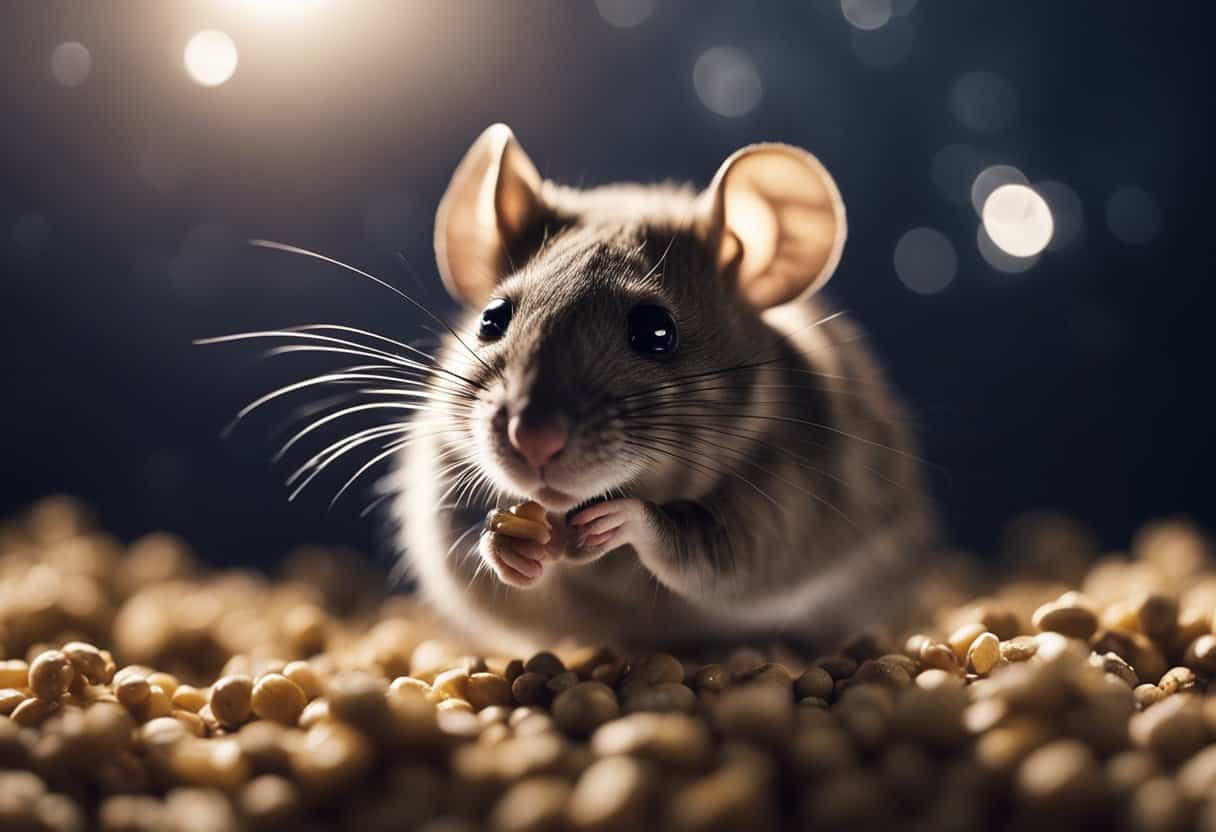
Mice are small but mighty creatures when it comes to eating. They typically eat approximately 15-20 times per day, constantly nibbling on food whenever they get the chance due to their high metabolism and small stomachs, necessitating frequent eating to sustain their energy levels.
Their feeding behavior is primarily nocturnal, with two main feeding periods just before sunset and just before dawn.
Their preference for nighttime feeding aligns with their natural instincts to avoid predators and forage during low light conditions, ensuring better safety while searching for food.
In terms of quantity, mice consume around 3-4 grams of food per day, which might not seem like a lot compared to their body size.
However, their consistent eating pattern helps them maintain their energy levels and satisfy their nutritional needs without overeating in a single sitting.
This regular but limited intake of food throughout the day provides steady sustenance without overwhelming their digestive system.
Consider it similar to snacking throughout the day.
For mice, the regular but limited intake of food throughout the day provides steady sustenance without overwhelming their digestive system.
Moreover, the preference for high-protein and high-fat foods is something to keep in mind when planning their meals. Designing a balanced diet that caters to these preferences is essential for meeting their dietary needs effectively.
By understanding the frequency and nature of mice feeding patterns, we can create an optimal feeding schedule that aligns with their natural instincts and dietary requirements.
This ensures that pet mice remain healthy and thriving in a domestic setting while also being conducive for scientific research on these fascinating little creatures.
In a study analyzing the feeding microstructure of mice, it was found that female mice ate less frequently but consumed larger meals during the night compared to males.
Additionally, the analysis of data from mice selected for increased and reduced appetite showed that the food intake decreased in later generations, suggesting changes in gene frequency over time.
Understanding how often mice eat sets the stage for exploring the intricacies of what and when they eat.
Let’s now venture into “Food Quantity and Timing”, delving deeper into providing for our tiny energetic companions.
Food Quantity and Timing
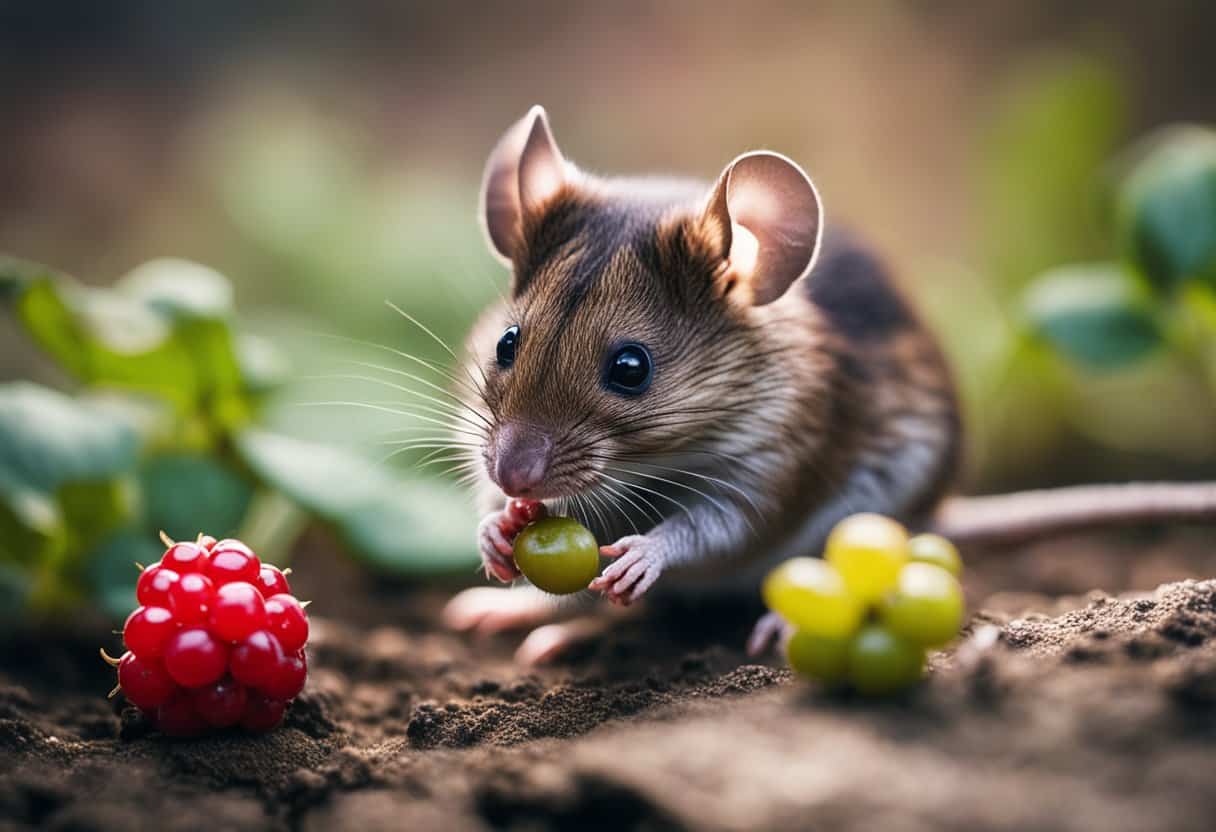
When it comes to food, mice don’t stock up like humans do. You might think they’d eat a lot at once, but actually, they nibble little bits throughout the night.
Their small size means they don’t need much food, but what they do eat, they consume often. Imagine having a tiny snack every few hours instead of sitting down for a big meal – that’s how these little critters munch away.
Mice can eat about 10 to 15% of their body weight every day.
To put it in perspective, just think about how much you weigh and then consider eating 10-15% of your own weight daily!
It’s a substantial amount for them even though it seems small to us.
But because they are so tiny, that’s all they really need to keep their energy up. These little creatures have high metabolisms and need to fuel up often to keep going.
Just like many modern diets recommend eating smaller meals throughout the day instead of three significant ones, mice operate on a similar system.
They don’t sit down for breakfast, lunch, and dinner like we do. Instead, they have about 15-20 meals each night—each time snacking on just a little bit.
It’s more like having a bowl of cereal or some fruit every few hours instead of three heavy meals.
Their routine is influenced by various factors such as food availability, environmental conditions, and social interactions within their group.
So while they usually feed at night when we’re sleeping, if there was an abundance of food or if something interrupted their mealtime (like our presence), they could change up their schedule quite easily.
Understanding their feeding habits and the frequency with which they eat helps us appreciate the role that food plays in a mouse’s life.
By providing small amounts of food regularly, you’re ensuring these little munchers have the energy they need to stay active and healthy.
Now let’s delve into how the diet affects other aspects of a mouse’s daily habits.
Influence of Diet on Mice Lifestyle
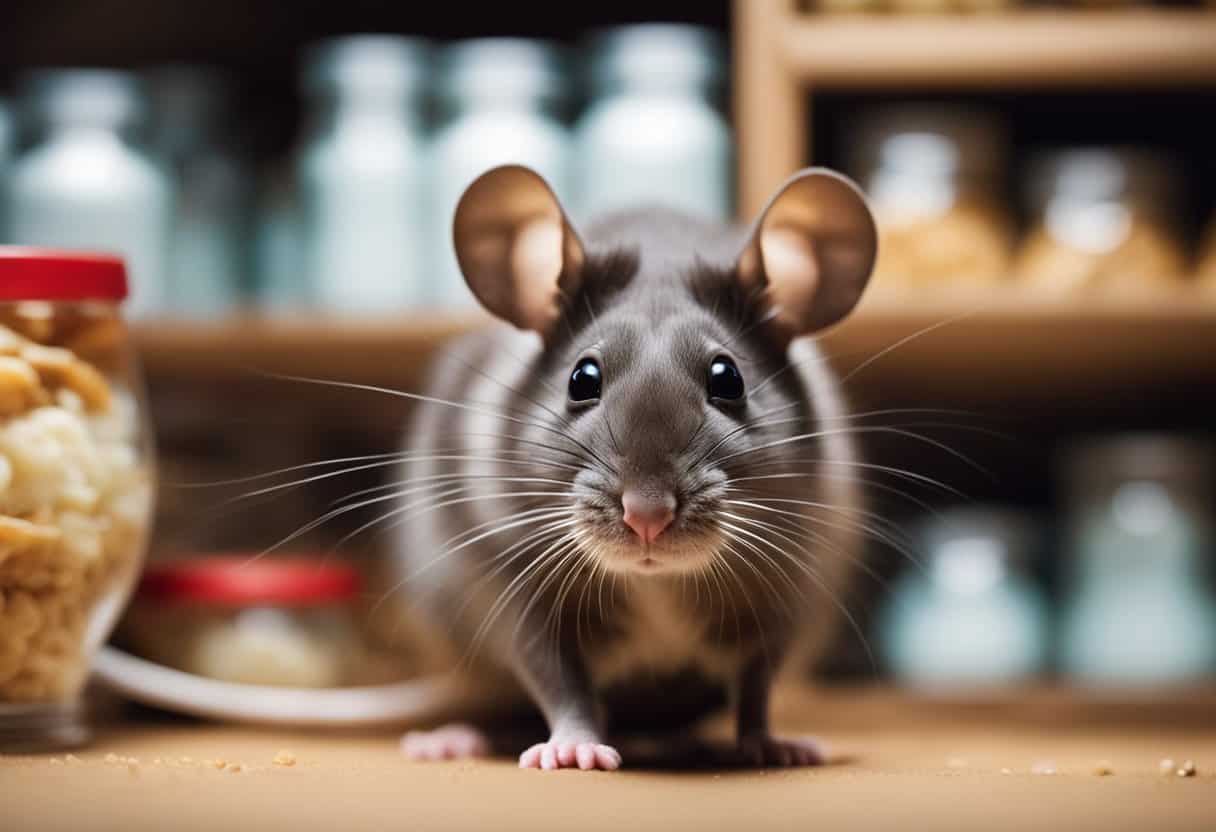
The diet of mice plays a significant role in dictating their lifestyle, particularly their scavenging behaviors and nesting patterns.
Mice are opportunistic feeders, meaning they will consume whatever food is most easily available to them.
This could range from grains and seeds to crumbs and scraps from human food.
When food is scarce, mice will forage further afield, increasing the likelihood of encroaching upon human habitats in search of sustenance.
Understanding the dietary preferences of mice is crucial for homeowners seeking to control or prevent infestations.
By comprehending what attracts mice to certain areas within a property, individuals can employ targeted pest management strategies such as the removal of food attractants and the strategic placement of bait stations or traps.
It’s important to recognize that mice have a high reproductive rate, and an abundant food supply only serves to bolster their population growth.
By denying them easy access to food sources within residential or commercial spaces, homeowners can mitigate the risk of infestations and ensure better overall hygiene.
For instance, eliminating clutter and keeping stored foods in tightly-sealed containers can help reduce the availability of readily accessible food sources for mice.
Furthermore, regularly disposing of garbage and not leaving pet food out overnight are additional measures that can significantly limit opportunities for mouse infestations.
Moreover, strategic placement of traps and baits near areas where mouse activity has been observed can help control their population and prevent further intrusion into living spaces.
By implementing these proactive measures informed by an understanding of mouse dietary behaviors, homeowners can safeguard against infestations, thereby ensuring the health and cleanliness of their living environment.
Now, let’s explore how hydration factors into the lifestyle of these tiny, resourceful creatures.
Mice Hydration Facts
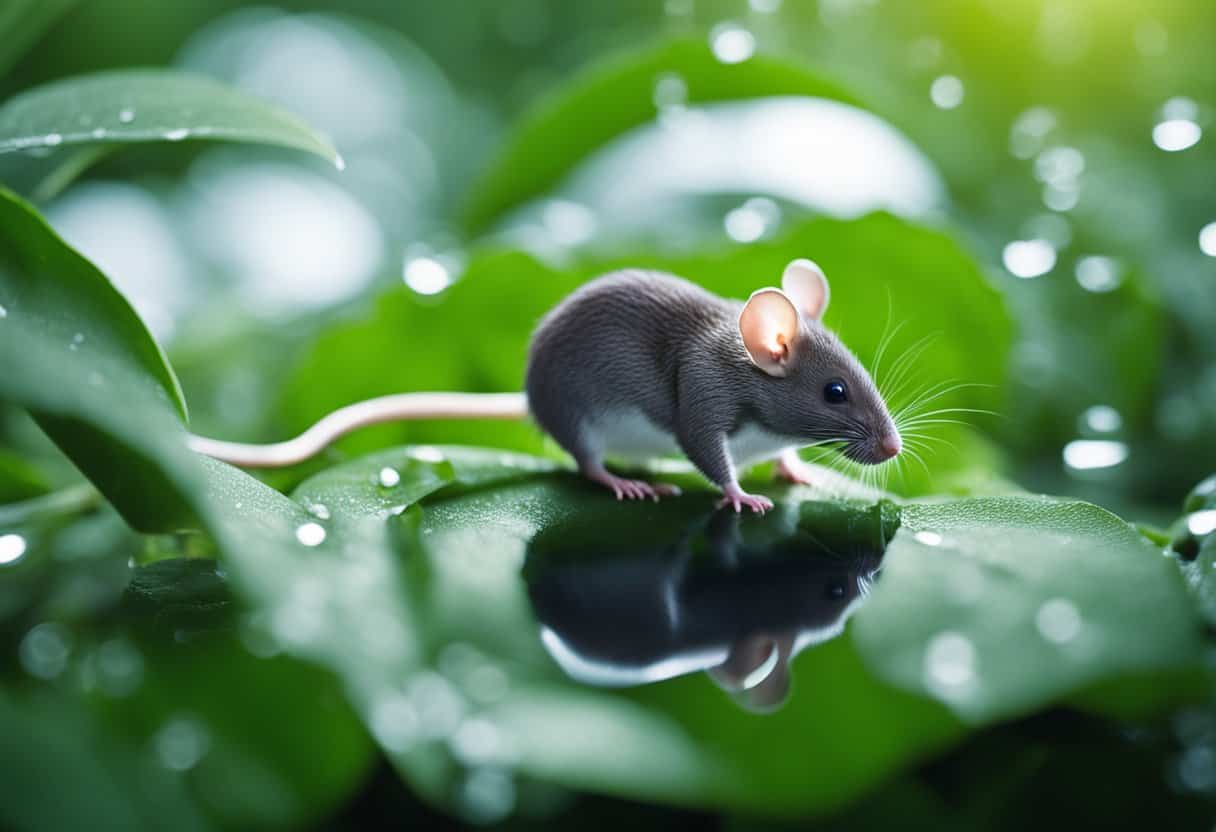
Mice have a remarkable ability to derive most of their required water intake from the food they consume.
While they do drink water when available, they primarily rely on their diet to stay hydrated.
In the wild, mice feast on a variety of foods such as seeds, grains, fruits, and vegetables.
These juicy fruits and veggies serve as a significant source of hydration for them.
It’s interesting to note that while many animals have a strong instinctual drive to seek out water sources, mice have adapted to survive on minimal water intake by satisfying most of their hydration needs through the moisture content in their food.
This unique ability to obtain moisture from their diet means that mice don’t need to consume water frequently like many other animals.
In fact, in lab settings, studies have shown that mice typically consume around 3-4 grams of food per day and drink approximately 5-10 milliliters of water per day.
This minimal requirement is fascinating and signifies their extraordinary adaptation to survive in various environments with varying access to water sources.
The ability of mice to thrive on a primarily food-dependent hydration regime also highlights the importance of providing them with a balanced diet.
Fruits and vegetables with a high moisture content are essential for keeping pet mice adequately hydrated, especially in captivity where their dietary intake is controlled by their caregivers.
Understanding the unique way in which mice maintain hydration through their food consumption sheds light on the significance of offering them a well-rounded diet.
This plays an essential role in supporting their overall health and vitality.
Nutritional Benefits of Mice Diet
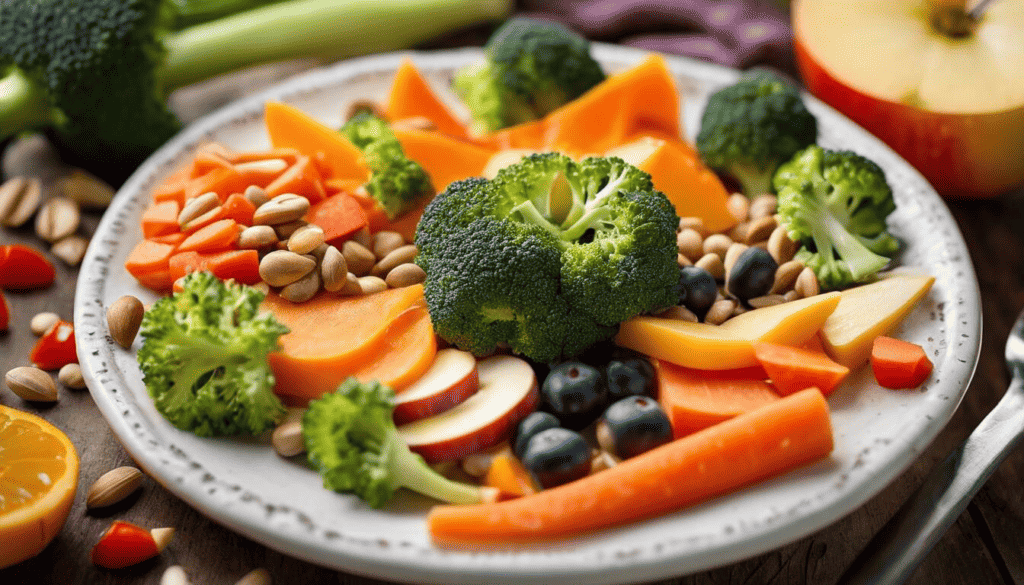
When it comes to what mice eat, their diet is quite diverse.
Mice are omnivores, meaning they consume a range of foods, including seeds, grains, and occasionally insects and small vertebrates.
This varied diet is not just about satisfying their taste buds; it actually provides them with the essential nutrients they need to thrive.
Seeds and grains form the bulk of a mouse’s diet, offering a good balance of proteins, fats, and carbohydrates.
Similar to us, mice require proteins for muscle growth and repair, fats for energy, and carbohydrates for quick bursts of fuel. Without these nutrients, they wouldn’t be able to scurry around as swiftly or build cozy nests for themselves.
Additionally, the occasional consumption of insects and small vertebrates gives them access to other important nutrients like vitamins and minerals.
For example, insects can be a source of crucial vitamins such as Vitamin A, which is vital for vision, immune function, and reproduction.
It’s fascinating to note that despite being tiny creatures, mice have specific dietary requirements that contribute to their overall health and vitality.
Taking inspiration from our diminutive friends in the wild, consider how critical it is to keep our own diets balanced with a mix of different foods to obtain the nutrition our bodies need.
In this way, mice are similar to us in needing a variety of nutrients for a healthy and active life.
Therefore, it’s clear that these little creatures rely on their diverse diet not just for survival but also for having enough energy to carry out all their daily activities.
Understanding the nutritional benefits of their diet gives us more insight into their behaviors and how they thrive in various environments.
With a deeper understanding of the nutritional needs of mice, let’s now explore how often they feed within a 24-hour period.
Feeding Frequency of Mice in 24 Hours
Mice are incredibly efficient eaters, typically consuming food between 15-20 times in a 24-hour period, which supports their high metabolic rate.
An interesting aspect of their feeding behavior is that they eat about 10-15% of their body weight each day, reflecting a constantly active appetite despite their small size.
Each feeding session lasts for around 5 minutes on average, highlighting their habit of frequent nibbling as they graze throughout the night. This constant need for food aligns with their quick metabolism and helps them maintain their energy levels.
Just picture the little mice scurrying around in the dark, stopping every now and then for a few minutes to fill up on food before they continue with their nightly activities.
Their scavenging nature leads them to feed opportunistically, taking advantage of any available food sources.
Therefore, understanding their feeding schedule is crucial when making informed decisions about strategic placements of baits and traps during pest control measures.
It’s clear that the feeding habits of mice are finely tuned to ensure their survival, allowing them to maintain energy levels by consuming numerous small meals throughout the night.
Understanding the intricacies of mouse feeding habits sheds light on effective pest management strategies that can be employed to keep these unwanted guests away from your premises.

